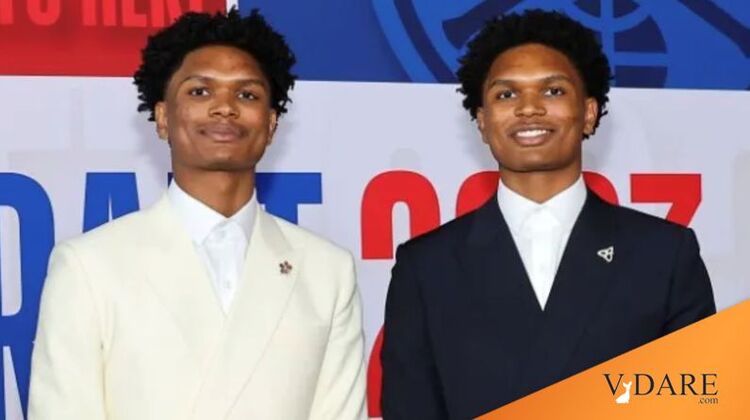
By Steve Sailer
06/24/2023
Unlike the British synth-pop trio of the 1980s, the basketball Thompson Twins really are identical twins:

The older twin Amen XLNC Thompson is 6’7″ 200 pounds and went #4 in the NBA draft. The younger twin Ausar XLNC Thompson, 6’7″ and 205 pounds, went #5.
Lots of Nature and Nurture in the Wikipedia write-up of Amen:
Thompson was born to Maya Wilson and Troy Thompson and raised in San Leandro, California. His identical twin brother, Ausar, was born one minute after him; they share the middle name “XLNC” (pronounced excellence) which was bestowed on them to convey a sense of power. Thompson’s older brother, Troy Jr., played college basketball for Prairie View A&M. His uncle, Mark Thompson, represented Jamaica in 400 meter hurdles at the 1992 Summer Olympics. He and Ausar began training for basketball under the guidance of their father by age seven and drew inspiration from LeBron James. The twins were homeschooled in sixth and seventh grade to focus on basketball.
Entering eighth grade, Thompson and his family moved to Fort Lauderdale, Florida so that he and Ausar could play high school basketball one year early at Pine Crest School. … After his junior year, Thompson held offers from Alabama, Arizona, Auburn, Arizona State and Kansas, among other programs, before deciding to not play college basketball. … On May 25, 2021, Thompson signed a two-year contract with Overtime Elite (OTE), a new professional league based in Atlanta with players between ages 16 and 20. He joined the league with his brother Ausar, bypassing his final year of high school and college, because he felt that it would prepare him best for the NBA.
In my 2022 review of the self-help book from data scientist Seth Stephens-Davidowitz, Don’t Trust Your Gut: Using Data to Get What You Really Want in Life, I outlined his method of estimating how important genes are in each sport:
Stephens-Davidowitz has a clever way to estimate how genetically determined success is in different sports: What proportion of siblings at the highest level are identical twins? For example, the NBA has had ten pairs of twins in its history, with at least nine pairs being identical. Of all the fraternal twosomes in NBA history, 11.5 percent have been identical twins, a very high fraction. If one identical twin is good enough to make the NBA, it appears the other has over a 50 percent chance of making it too. The author guesstimates that genes determine 75 percent of basketball success.
Not surprisingly, considering how dependent basketball success is upon height, which these days is overwhelmingly genetic in origin, that makes basketball one of the four sports where genes matter most.
The most genetically influenced sport is track and field, where an astonishing 22.4 percent of all Olympic same-sex siblings have been identical twins.
Next are wrestlers, where 13.8 percent of Olympic brothers have been monozygotic twins, followed by 12.4 percent of rowers, such as the 2008 Olympian Winklevoss twins who are jointly played by Armie Hammer in the movie The Social Network. When considering suing Mark Zuckerberg for stealing their idea for what became Facebook, one suggests giving the Zuck an old-fashioned thrashing instead. After all, he reasons, “I’m 6′ 5″, 220 pounds, and there’s two of me!”
In contrast to twin-rich basketball, only 1.9% of major league baseball brothers have been identical twins. An identical twin of an MLB player has only a 14 percent chance of making the big time. According to Don’t Trust Your Gut, baseball skill is only about 25 percent genetic.
The latest baseball twins (and the first since Jose and Ozzie Canseco in the early 1990s) are relief pitchers Taylor and Tyler Rogers. Oddly, while Taylor is a conventional power-pitching lefty with a 96-mile-per-hour sinker, soft-throwing righty Tyler only made it to The Show by learning how to pitch submarine-style. His fastball averages merely 83 mph, but he has a weird slider that breaks up rather than down. Evidently, even identical twins aren’t always terribly similar.
My guess is that while pitching potential is fairly genetic, pitching accomplishment is highly contingent on random arm injuries.
This is a content archive of VDARE.com, which Letitia James forced off of the Internet using lawfare.